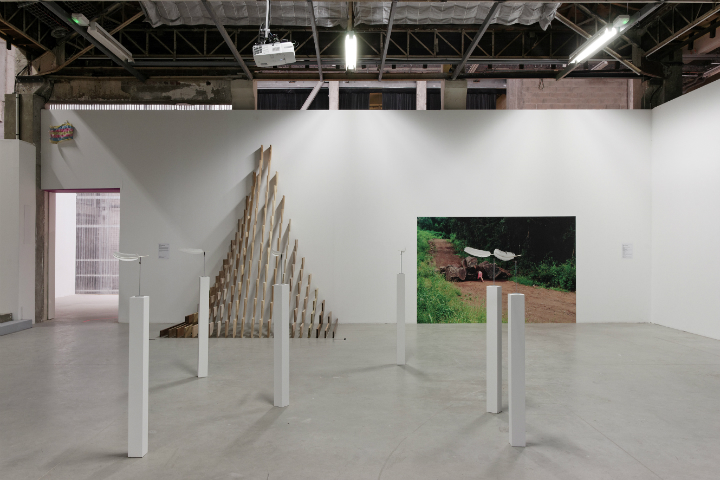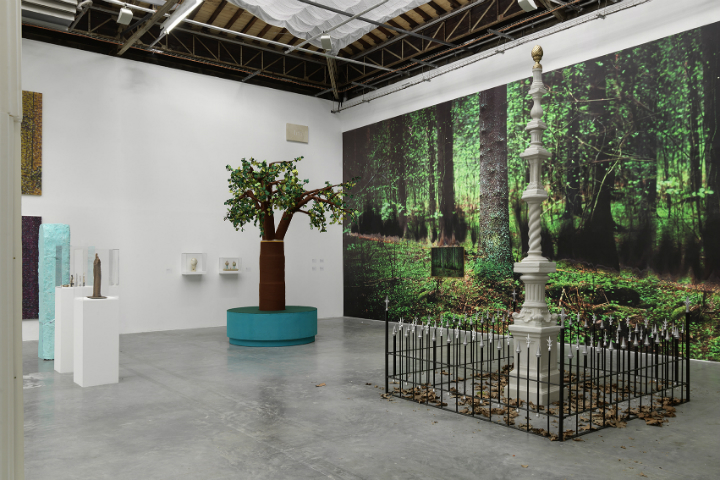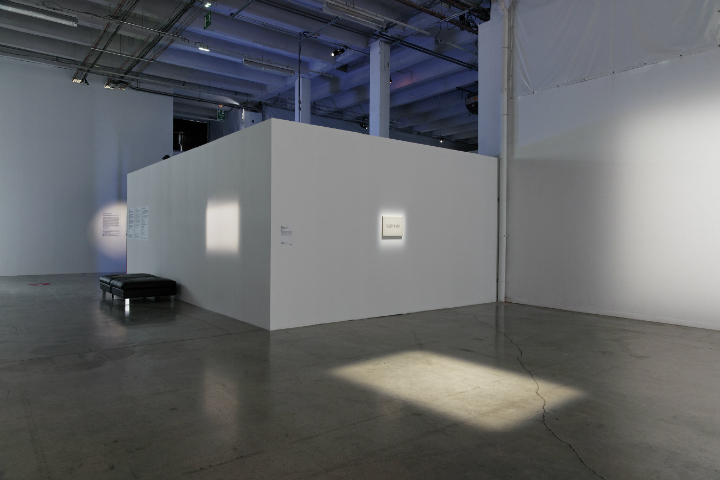The Art Tsunami: Nouvelles Vagues at Palais de Tokyo and beyond
- (first published on artlifemagazine.com)
- Jul 4, 2013
- 8 min read
Updated: Mar 24, 2020
(Paris.) It's summer, again. Parisians leave for holidays, non-Parisians arrive for holidays. The Tamil street vendors have changed their umbrellas for water bottles, all Velibs are taken, and galleries do a group show. But something is different this year: All Paris is only one giant group show.
The biggest group show the city has ever seen. Organized by Palais de Tokyo and named Nouvelles Vagues (New Waves) it unites fifty-three exhibitions to celebrate the art(?) of curating. To participate, a gallery could not simply hold their annual summer sale, but needed to hire a professional curator (and be a member of National Committee of Art Galleries who acted as PdT's intermediary).
The profession of a curator is unique, something between a movie director and a DJ (without manipulating, scratching, pitching the artworks, of course). Only the most basic definition seems valid for every act of curating: A curator chooses artworks for an exhibition. All the rest depends on the occasion. Curating means to make a selection, to know and to decide, and there are innumerable ways to do it. Ideas, concepts, catchwords, colors, politics, books, etc. are possible starting points for curating. And, of course, personal taste in art or artists, the omnipresent networking, can guide a curator too, though he will always insist on using rational guidelines. The curator may chose existing, more or less historic, works, or influence the creative process itself and ask for a piece to be specially produced to match the concept (existentialist vs. essentialist curating?). There are few limits indeed.
The Nouvelles Vagues arrived at Paris on a Thursday night with the opening at Palais de Tokyo, where some regulars wondered about the closed terrace, the party was only inside. Two days later business as usual when the galleries opened their shows: having a drink with friends and colleagues for the ones; see and be seen buying for the others. The definite crowd-puller of rue Saint Claude (contemporary art's main street) was Torri where curator Jonathan Chauveau presents Bloody Mary, and he served them personally. Chauveau definitely has a talent here, being extremely generous with Vodka and Tabasco, but not exaggerating on the Worcester sauce. His Eucharistic act got accompanied by a man playing piano (thankfully no New Wave). Seldom Tor(r)ies have had as much success with art people (for the record: the dealer's name is Romain Torri). The exhibition itself has some good ingredients too, though the exact concept is not very obvious. A fake blood pool and an obscene puppet by Gregor Schneider (possibly inspired by a scene in Kevin Smith's cult movie Clerks) could hint to some crime/horror idea, but allegedly there is a link to an art collector and his apartment (?).
Nearly the whole street takes part in Nouvelles Vagues, from Anne Barrault (curated by Isabelle le Normand) and Jousse Entreprise (curated by Vanessa Desclaux) to Alberta Pane (Historico-Vagabond, curated by Javier Villa and Marie Frampier, with the historic debuts of Public Relations, a sculpted soap opera by Jeanne Gillard & Nicolat Rivet, fake archeology with Jasper Coppes and the best answer to severe art critique ever from Fabio Kacero). Even Perrotin the Great chose to honor the project with his participation. It's a bit of a pity though, how Perrotin Gallery needed the help of curator Tom Morton to finally invite one of the world's best artists without a dealership in Paris: Charles Avery. For It Means It Means, he lets the inhabitants of Onomatopoeia, the main city of the imaginary island on which all of his works "play", interact with classics of contemporary art. How will the Islanders react to Marcel Duchamp, Marina Abramovich & Ulay, Jeff Koons and many more? Curating becomes a topic of art itself in literal citations that excede the habitual arrangement of historical ideas by learned artists. Narrative, abstract, intellectual, challenging, philosophic, historic, in one word: Charles Avery's drawings are brilliant.
The Nouvelles Vagues rolled over the Seine's left bank as well, to reach galleries that are usually not dedicated to contemporary art. Le Minotaure and Galerie 1900-2000 hired French star artists Laurent Grasso and Matthieu Mercier respectively to curate their summer shows. Laurent Grasso visibly had fun in Galerie 1900-2000's archives from where he surfaced with works from Francis Picabia, Man Ray, Hans Bellmer etc., he also added one of his own pseudo classic paintings. His works often center on artistic continuities throughout the ages. Mathieu Mercier on the other hand focused on the idea of zooming in/zooming out, micro and macrocosm, to which he was inspired by an exhibition of historic photographer Carl Strüwe at Le Minotaure last year. It suits well the whole project of fifty-three shows with who-knows-how-many artists in one.
This can only be a tiny selection of gallery shows, curated by Artlife Magazine for various motives (bribery by Bloody Mary being one of them). The same is true for the following lines on Nouvelles Vagues at Palais de Tokyo itself. A list of examples, no highlights but equals amongst peers, and there would be so much more to write about.
Twenty-one exhibitions take place in the Palace, and surprise: this time it's easy not to get lost during the visit (would somebody there have heard our prayers ...?) A straight - or curved, but clearly limited in any case - route leads through three storeys, there is even a red line painted to the floor for orientation. Following it the visitor meets all kinds of different approaches to curating.
A fine example of mixing artworks from different ages and genres present Gallien Déjean and Fanny Schulmann with Le club des sous-l'eau (The Underwater Club), inspired by a group of diving enthusiasts from the 1930s and their explorations in best Jules Verne tradition. In a backroom a 16th Century book joins a black and white film documentary and hypnotic flickering on another screen, to evoke the mysteries of unknown lands, but also the disenchantment of myths in science. As a sort of meta-art, this installation exceeds its parts by far.
Arte Sure website is a project of Albertine de Galbert (yep, name sounds familiar) to catalogue Latin American artists. For Nouvelles Vagues, she invited four fellow curators (Isabelle Le Normand, Andrew Berardini, Jesse McKee, Anca Rujoiu). As none of them is an expert in South American art, the result is a selection from four external points of view, plus Miss de Galbert's intervention. This becomes most obvious with Ivan Argote, a Columbian artist of Perrotin Gallery, whose video Feeling has been shown much too often in Paris before (this seems actually the laziest decision of any curator involved in Nouvelles Vagues, but maybe it's been meant ironic?). The rest of the works is more surprising, like Manuela Ribadeneira's fragile feathers, or Leyla Cárdenas' mural (a truly Latin tradition) scratched into the wallpaper; to name but two of many great artworks. Tamara Kuselman's film on how she once curated her own exhibition with the help of a fortuneteller's tarot cards adds further reflection on the arbitrariness (or supernatural predestination?) of curating.
What makes Arte Sure remarkable is furthermore how it creates the impression of a harmonious whole, partly due to the white space that seems somehow whiter here than elsewhere (thankfully it's not the rule at Palais de Tokyo where the building's rough industrial ambiance often helps to focus on the artworks as they are). Art gets swallowed up in white noise, even more so as many of these works feature the non-color themselves.
A similar effect reaches Memorial Park curated by Haeju Kim. There is sound, there is a video, and there are writings on the walls, three artists have been involved, but it feels like only one - and only one work. To talk of a minimalist Zen attitude as the link between Korean artists Theresa Hak Kyung Cha, Sora Kim and Hwayeon Nam, would probably be too much of a stereotype, but still...
Much focused on videos is The Real Thing curated by Antonia Alampi and Jason Waite, with war games in different landscapes, and Pilvi Takala in Snow White disguise being refused entry to Disneyland (you will find it on YouTube). Art as a simulacrum fights the fake realities. For their pages in the catalogue, the curators decided to publish a text from some Kindergarten Marxist. Oh Sancta Simplicitas, there is no real thing.
And then, there is death.
Champs Elysees (Elysian Fields), curated by Julie Boukobza, Simon Castets and Nicola Trezzi, is a morbid, yet very bright show.
A waxen gipsy sorceress lying on two chairs to have a chat with that lonely soul or two who might be floating her way (artist: Goshka Maçuga), a dead plastic tree (Lara Favaretto) in front of a wall-taking photograph of a peaceful forest (Harold Ancart), antique steles, etc., we find as much mystery as humor.
James Isenstein presents his proper Book of the Dead, that has nothing to do with the sacred Tibetan and Egyptian texts of the same name, and even less with a "certain hideous work of the Mad Arab Abdul Alhazred, translated into Latin by Olaus Wormius, full of blasphemous secrets too hideous to ever be mentioned to human ears. In short, what's written in there is this: ..." (sorry, H.P. Lovecraft. And end of off-topic). James Isenstein's Book of the Dead is nothing more than a - or in fact a collection of ten - guestbooks filled in by people who one day will have ended this life and, according to your personal viewpoint, will be playing harp in a fluffy flower garden, start it all over once again in a different body, enjoy the eternal pleasures of seven virgin wh-- girls, or whose brain streams will simply be deactivated for good. Great also Alice Tomaselli's work between honesty and caricature. Her installation instructions demand to put as many flowers into a vase as there are artists in the show. Then add an artificial, and thus immortal (well: dying much later) one, to represent Alice Tomaselli herself. Artistic aspiration and megalomania, or a lesson on relativity.
And finally one more fascinating approach offers The Floating Admiral, curator: Ana Mendoza Aldana. An interactive crime story from 1931 transformed into a visual narrative on the death of painting. Sounds abstract? It is.
Nouvelles vagues deserves all our respect. It will keep the art world busy for weeks, to see it all takes its time.
In theory, curators at Palais de Tokyo have more liberties to create an experience as they are unaffected by commercial considerations (apart from their own), but there are no obvious differences to the gallery shows. An interesting aspect might be the shift of relevance in this project. Fifty-three exhibitions curated by often more than one curator, with an average of five artists each, makes two hundred and sixty-five artists, and many more artworks. What will the visitor retain?
The name of a work, an artist, a curator? Or not rather a label - Palais de Tokyo?
Maybe the importance of curators should not be overestimated - a great work of art is a great work of art all by itself, and great museum collections don't need to be "curated" in the modern sense - the distribution into different departments according to origin in time and place is not curating. Maybe the fascination of curating derives from its ability to change a work's meaning. Unlike a presentation alone or in the mass (-->Louvre), where it stands for itself, curating adds something that doesn't make the work better, nor worse, only different. And that's why curating might well be an artistic act.
Nouvelles Vagues, Palais de Tokyo, and everywhere about Paris, 20 June-09 September 2013 (galleries are closed for holidays in August)














Comments